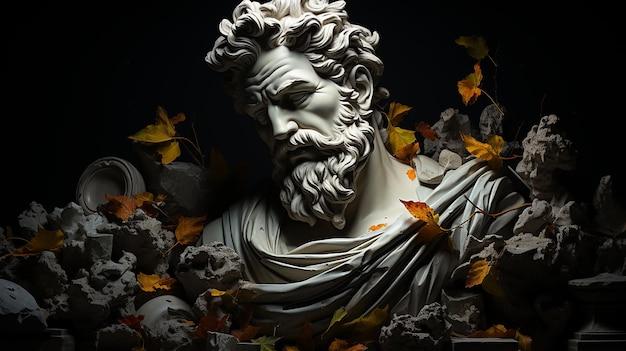Art has always been a fascinating and intrinsic part of human culture and expression. From music to painting and sculpture, these art forms captivate our senses and evoke emotions that words alone cannot. But why are music, painting, and sculpture specifically referred to as “fine arts”? In this blog post, we will delve into the origins of this classification and explore what sets these forms of art apart from others. We will also discuss the significance of sculpture in the realm of fine arts and the distinctions between fine arts and decorative arts. So, grab a cup of coffee and join us as we unravel the beauty of the fine arts.
Why Are Music, Painting, and Sculpture Called Fine Arts
Art has always been a way for human beings to express their creativity, emotions, and ideas. It takes various forms, but three of the most prominent and revered art forms are music, painting, and sculpture. These three art forms are often referred to as “fine arts.” But have you ever wondered why they are called that? Let’s delve into the origins and reasons behind this designation.
The Historical Definition of Fine Arts
In the classical sense, the term “fine arts” encompassed seven disciplines: architecture, sculpture, painting, music, poetry, dance, and drama. These seven arts were considered “fine” due to their elevated nature and association with aesthetics. They were believed to elevate the human spirit and provide pleasure to both the creators and the audience.
Music: The Invisible Art
Music, an art form that exists solely in the realm of sound, may seem like an odd choice for the label of “fine art.” Unlike paintings or sculptures, it doesn’t have a tangible form that can be physically appreciated. However, music has a profound impact on human emotions and can evoke powerful feelings of joy, sadness, or excitement. It is a harmonious blend of melody, rhythm, and harmony that stimulates our senses and touches our souls.
Painting: A Visual Symphony
Painting is the art form that most readily comes to mind when we think of “fine arts.” It involves the skillful application of pigments to create a visual representation of an artist’s thoughts, feelings, or observations. Paintings have the power to transport us to different worlds, evoke emotions, and make us ponder the deeper meanings within them. They capture fleeting moments, immortalize people and places, and serve as mirrors of the human condition.
Sculpture: From Stone to Life
Sculpture is a three-dimensional art form that brings life to inanimate materials such as stone, wood, or metal. Sculptures have the power to captivate viewers with their craftsmanship, beauty, and ability to depict human forms and emotions. From the delicate chisel work of Michelangelo’s “David” to the grandeur of the Statue of Liberty, sculptures make a lasting impression and leave us in awe of the artist’s skill and vision.
The Common Thread: Creativity and Skill
What unites music, painting, and sculpture under the umbrella of fine arts is the display of both creativity and skill. Artists in these disciplines use their imagination, technical expertise, and years of practice to create something extraordinary. Their works are a testament to the power of human ingenuity and the pursuit of aesthetic excellence.
Although the specific reasons for why music, painting, and sculpture are called fine arts may differ slightly, they all share the common goal of inspiring and captivating humanity. These art forms transcend time, culture, and language barriers, enriching our lives with their beauty and emotional depth. So next time you listen to a symphony, gaze at a painting, or marvel at a sculpture, remember that you are experiencing the power and splendor of the fine arts.
FAQ: Why Are Music, Painting, and Sculpture Called Fine Arts
In the world of creative expression, there are numerous forms of art that captivate our senses and stir our emotions. From the vibrant strokes of a painting to the harmonious melodies of music and the intricate craftsmanship of sculpture, these artistic endeavors have been labeled as “fine arts.” But why exactly are music, painting, and sculpture given this lofty title? In this FAQ-style article, we will delve into the distinctions between fine arts and other art forms, explore the significance of sculpture in the art world, and unravel the connection between music and art. So sit back, relax, and prepare to have your artistic curiosity satisfied!
What distinguishes a sculpture as a piece of fine art
When we think of sculpture, we often envision stunning works crafted from various materials like marble, bronze, or even found objects. But what sets a sculpture apart as a fine art piece? Well, it all boils down to intention and execution. A sculpture is considered fine art when it goes beyond mere utility or craftsmanship and embodies a deeper artistic expression. Fine art sculptures provoke thought, evoke emotions, and showcase the creative vision of the artist. So next time you marvel at a thought-provoking sculpture, remember that it’s not just an object; it’s a work of fine art!
What is the difference between sculpture and painting
While both sculpture and painting fall under the umbrella of fine arts, they differ in significant ways. Sculpture is a three-dimensional art form that involves shaping and manipulating materials to create physical objects. It relies on the interplay of light and shadow, texture, and form to communicate its artistic message. On the other hand, painting is a two-dimensional art form that utilizes pigments applied to a surface, typically on canvas or paper. Paintings can evoke emotions, depict scenes, or convey abstract concepts through the skilled use of color, composition, and brushwork. In short, sculpture exists in the realm of solidity, while painting thrives in the land of visual representation.
Why is music considered as an art
Ah, music, the universal language that transcends boundaries and touches our souls. But is it really a fine art? Absolutely! Music is considered art because it encapsulates creativity, expression, and aesthetic value. It combines melody, rhythm, harmony, and lyrics to create a form of sensory beauty that resonates with our emotions. Whether it’s through symphonies, rock anthems, or soulful ballads, music has the power to move us, uplift our spirits, and ignite our imaginations. So crank up your favorite tunes, and let the artistry of music sweep you away!
What are auditory arts
When it comes to art, we tend to focus on visual aspects like paintings and sculptures. However, the world of art extends beyond what meets the eye. Auditory arts encompass forms of creative expression that are experienced primarily through sound. This includes music, spoken word performances, sound installations, and even experimental audio compositions. Auditory arts broaden our understanding of artistic possibilities and remind us that creativity knows no bounds. So if you ever find yourself lost in the mesmerizing beats of a drum or the enchanting melodies of a flute, you’re experiencing the auditory arts in all their glory.
What is the difference between fine arts and decorative arts
Fine arts and decorative arts might sound similar, but they inhabit different realms of artistic pursuit. Fine arts prioritize aesthetics, creativity, and conceptual depth. They strive to provoke emotions, challenge societal norms, and communicate profound messages. On the other hand, decorative arts prioritize functionality, craftsmanship, and the embellishment of everyday objects. They include disciplines like pottery, textiles, jewelry, and furniture design. While both have their place in the art world, fine arts push the boundaries of artistic expression, making us question, reflect, and appreciate the power of human creativity.
Why is sculpture important in art
Sculpture holds a special place in the realm of art for its ability to transcend the constraints of two-dimensionality and exist in the tangible world. It engages not only our eyes but also our sense of touch, inviting us to explore its textures and contours. Sculpture creates a physical presence that demands our attention and sparks our imagination. From ancient masterpieces depicting mythical creatures to modern abstract sculptures arousing intellectual curiosity, this art form offers us a chance to experience art in a unique and immersive way. So next time you encounter a captivating sculpture, take a moment to appreciate how it invites you to interact with it and ponder its meaning.
Can painting be called craft
While painting is undoubtedly a skill that requires craftsmanship, it is commonly classified as a fine art rather than a craft. Craft focuses on the technical mastery of a particular discipline, emphasizing functionality and practicality. On the other hand, painting delves into the realm of aesthetics, symbolism, and personal expression. Paintings often strive to convey a message or evoke an emotional response, distinguishing them as fine art forms. So the next time you appreciate a breathtaking painting, remember that, unlike a functional craft, it seeks to move your heart and mind.
Why is painting considered an art
Painting has been revered as an art form for centuries, and for good reason. It encapsulates the human capacity for creativity, imagination, and storytelling. Through a harmonious interplay of color, composition, and brushwork, paintings transport us to other worlds, evoke deep emotions, and make us see things from a fresh perspective. They capture fleeting moments in time, immortalize beauty, and allow artists to express their unique vision of the world. In short, painting is considered an art because it intertwines the tangible with the intangible, the visible with the invisible, and gives life to a canvas that speaks to our souls.
As we conclude this FAQ-style exploration of why music, painting, and sculpture are labeled as fine arts, we hope that your understanding of these art forms has deepened. We discovered that the distinction lies in intention and execution, with fine art transcending mere utility or craftsmanship. Sculpture stands as a three-dimensional embodiment of creative expression, while painting captivates with its two-dimensional visual representation. And let’s not forget music, the art form that connects with us on an emotional level through the harmonious interplay of melody and lyrics. So the next time you immerse yourself in the realm of fine arts, allow their beauty to awaken your senses and kindle your imagination. After all, art exists to be experienced, appreciated, and cherished. Cheers to the enchanting world of fine arts!

